
Data Analysis
Andrey Shestakov (avshestakov@hse.ru)
Linear regression. Gradient-based optimization1
1. Some materials are taken from machine learning course of Victor Kitov
Let's recall previous lecture¶
- Decision trees
- Utilize the notion of impurity
- Work both for classification and regression
- Implicit feature selection
- good for features of different nature
- Parallel to axes class separating boundary
- Local greedy optimizaion
- Sensitive to even tiny data pertubations
Linear regression¶

df_auto.plot(x='mileage', y='price', kind='scatter')
<matplotlib.axes._subplots.AxesSubplot at 0x110515810>
Linear regression¶
- Our goal - determine linear dependence between features $X$ and target vector $y$
- Define $X\in\mathbb{R}^{NxD},\{X\}_{ij}$ defines the $j$-th feature of $i$-th object, $y\in\mathbb{R}^{n}$, $y_{i}$ - target value for $i$-th object $$f(x, \beta) = \hat{y} = X\beta \quad \Leftrightarrow \quad f(x_{n}, \beta) = \hat{y}_{n} = \beta_0 + \beta_1x_{n}^1 + \dots$$
- Need to estimate $\beta_i$.
Ordinary Lears Squares:
$$ L(\beta_0,\beta_1,\dots) = \frac{1}{2N}\sum^{N}_{n=1}(\hat{y}_{n} - y_{n})^2 = \frac{1}{2N}\sum^{N}_{n=1}\left(\sum_{d=1}^{D}\beta_{d}x_{n}^{d}-y_{n}\right)^{2} \rightarrow \min\limits_{\beta} $$
$$ \Updownarrow $$
$$ L(\beta) = \frac{1}{2N}(\hat{y} - y)^{\top}(\hat{y} - y) = \frac{1}{2N}(X\beta - y)^{\top}(X\beta - y) \rightarrow \min\limits_{\beta} $$
Solution¶
Let's say $f(x, \beta) = \beta_0 + \beta_1x_1$
Calculate partial derivatives wrt $\beta_0$, $\beta_1$ and set them to $0$:
$$ \frac{\partial L}{\partial \beta_0} = \frac{1}{N}\sum^{N}_{n=1}(\beta_0 + \beta_1x_{n}^1 - y_{n}) = 0$$ $$ \frac{\partial L}{\partial \beta_1} = \frac{1}{N}\sum^{N}_{n=1}(\beta_0 + \beta_1x_{n}^1 - y_{n})x^1_{n} = 0$$
Solution (in matrix form)¶
Either with matrix calculus or with some linear algebra trick we get
$$ X^{T}(X\beta-y)=0 \quad \Leftrightarrow \quad \beta = (X^\top X)^{-1} X^\top y \quad\text{(Normal Equation)}$$
Comments¶
- This is the global minimum, because the optimized criteria is convex.
- Geometric interpretation:
- find linear combination of feature measurements that best reproduce $y$
- solution - combinaton of features, giving projection of $y$ on linear span of feature measurements.
- Why using Normal Equation could be bad?
- Calculating inverse costs a lot
- Not all matrices have it (singular matrices)
Linearly dependent features (multicollinearity)¶
- Solution $\widehat{\beta}=(X^{T}X)^{-1}X^{T}y$ exists when $X^{T}X$ is non-singular
- Problem occurs when one of the features is a linear combination of the other (linear dependency)
- because of the property $\forall X:\,rank(X)=rank(X^{T}X)$
- interpretation: non-identifiability of $\widehat{\beta}$ for linearly dependent features:
- linear dependence: $\exists\alpha:\,x^{T}\alpha=0\,\forall x$
- suppose $\beta$ solves linear regression $y=x^{T}\beta$
- then $x^{T}\beta\equiv x^{T}\beta+kx^{T}\alpha\equiv x^{T}(\beta+k\alpha)$, so $\beta+k\alpha$ is also a solution!
- Multicollinearity can be exact and not exact, which is also bad
- Dummy variable trap!
Linearly dependent features¶
- Problem may be solved by:
- feature selection
- dimensionality reduction
- imposing additional requirements on the solution (regularization)
Analysis of linear regression¶
Advantages:
- single optimum, which is global (for non-singular matrix)
- analytical solution
- interpretable solution and algorithm
Drawbacks:
- too simple model assumptions (may not be satisfied)
- $X^{T}X$ should be non-degenerate (and well-conditioned)
Intuition¶
$$ L(\beta_0, \beta_1) = \frac{1}{2N}\sum_{n=1}^N(\beta_0 + \beta_1x^1_{n} - y_{n})^2$$
- Suppose we have some initial approximation of $(\hat{\beta_0}, \hat{\beta_1})$
- How should we change it in order to improve?
sq_loss_demo()
Tiny Refresher¶
Derivative of $f(x)$ in $x_0$: $$ f'(x_0) = \lim\limits_{h \rightarrow 0}\frac{f(x_0+h) - f(x_0)}{h}$$
Derivative shows the slope of tangent line in $x_0$
- If $x_0$ is extreme point of $f(x)$ and $f'(x_0)$ exists $\Rightarrow$ $f'(x_0) = 0$
interact(deriv_demo, h=FloatSlider(min=0.0001, max=2, step=0.005), x0=FloatSlider(min=1, max=15, step=.2))
<function __main__.deriv_demo>
Tiny Refresher¶
- In multidimential world we switch to gradients and directional derivatives: $$ f'_v(x_0) = \lim\limits_{h \rightarrow 0}\frac{f(x_0+hv) - f(x_0)}{h} = \frac{d}{dh}f(x_{0,1} + hv_1, \dots, x_{0,d} + hv_d) \rvert_{h=0}, \quad ||v|| = 1 \quad \text{directional derivatives}$$
$$ \frac{ \partial f(x_1,x_2,\dots,x_d)}{\partial x_i} = \lim\limits_{h \rightarrow 0}\frac{f(x_1, x_2, \dots, x_i + h, \dots, x_d) - f(x_1, x_2, \dots, x_i, \dots, x_d)}{h} \quad \text{partial derivative}$$
$$ \nabla f = \left(\frac{\partial f}{\partial x_i}\right),\quad i=1\dots d \quad \text{Gradient = a vector of partial derivatives}$$
Tiny Refresher¶
- Unsing multivariate chain rule:
$$ f'_v(x_0) = \frac{d}{dh}f(x_{0,1} + hv_1, \dots, x_{0,d} + hv_d) \rvert_{h=0} = \sum_{i=1}^d \frac{\partial f}{\partial x_i} \frac{d}{dh} (x_{0,i} + hv_i) = \langle \nabla f, v \rangle$$
$$ \langle \nabla f, v \rangle = || \nabla f || \cdot ||v|| \cdot \cos{\phi} = || \nabla f || \cdot \cos{\phi}$$
Tiny Refresher¶
$$ \langle \nabla f, v \rangle = || \nabla f || \cdot \cos{\phi}$$
- Directional derivative is maximal what direction is collinear to gradient
- gradient — direction of steepest ascent of $f(x)$
- antigradient — direction of steepest descent of $f(x)$
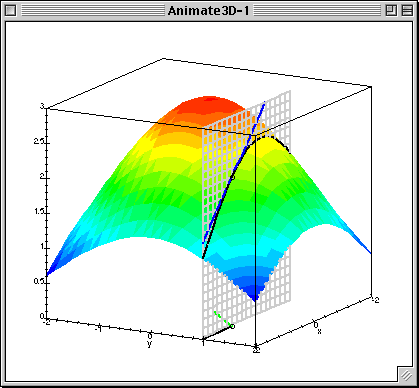
Given $L(\beta_0, \beta_1)$ calculate gradient (patial derivatives) $$ \frac{\partial L}{\partial \beta_0} = \frac{1}{N}\sum^{N}_{i=1}(\beta_0 + \beta_1x_{n}^1 - y^{n})$$ $$ \frac{\partial L}{\partial \beta_1} = \frac{1}{N}\sum^{N}_{i=1}(\beta_0 + \beta_1x_{n}^1 - y^{n})x^1_{n}$$
Or in matrix form: $$ \nabla_{\beta}L(\beta) = \frac{1}{N} X^\top(X\beta - y)$$
Run gradient update, which is simultaneous(!!!) update of $\beta$ in antigradient direction:
$$ \beta := \beta - \alpha\nabla_{\beta}L(\beta)$$
- $\alpha$ - descent "speed"
Pseudocode¶
{python}
1.function gd(X, alpha, epsilon):
2. initialise beta
3. do:
4. Beta = new_beta
5. new_Beta = Beta - alpha*grad(X, beta)
6. until dist(new_beta, beta) < epsilon
7. return betagrad_demo(iters=105, alpha=0.08)
Comments¶
- How do we set $\alpha$
- Feature scales matters

- Local minima*
Stochastic gradient descent¶
{python}
1.function sgd(X, alpha, epsilon):
2. initialise beta
3. do:
4. X = shuffle(X)
5. for x in X:
6. Beta = new_beta
7. new_Beta = Beta - alpha*grad(x, beta)
8. until dist(new_beta, beta) < epsilon
9. return betastoch_grad_demo(iters=105, alpha=0.08)
Momentum¶
Idea: to move not only to current antigradient direction but consider previous one
$$ v_t = \gamma v_{t - 1} + \alpha\nabla_{\beta}{L(\beta)}$$ $$ \beta = \beta - v_t$$
where
- $\gamma$ — momentum term (usually 0.9)
Adagrad¶
Idea: update parameters $\beta_i$ for each feature differenly.
Denote $\frac{\partial L}{\beta_i}$ on iteration $t$ as $g_{t,i}$
Vanilla gd update
$$ \beta_{t+1, i} = \beta_{t, i} - \alpha \cdot g_{t,i}$$
In Adagrad $\alpha$ is normalized wrt "size" of previous derivatives:
$$ \beta_{t+1, i} = \beta_{t, i} - \dfrac{\alpha}{\sqrt{G_{t,ii} + \varepsilon}} \cdot g_{t,i}$$
where $G_t$ is diagonal matrix with sum of squares of derivatives of $\beta_{i}$ before iteration $t$. $\varepsilon$ — is smoothing hyperparameter.
FYI¶
- Zero-order methods
- like...
- 2nd order methods
- Newton method
Nonlinear dependencies¶
Generalization by nonlinear transformations¶
Nonlinearity by $x$ in linear regression may be achieved by applying non-linear transformations to the features:
$$ x\to[\phi_{0}(x),\,\phi_{1}(x),\,\phi_{2}(x),\,...\,\phi_{M}(x)] $$
$$ f(x)=\mathbf{\phi}(x)^{T}\beta=\sum_{m=0}^{M}\beta_{m}\phi_{m}(x) $$
The model remains to be linear in $\beta$, so all advantages of linear regression remain.
Typical transformations¶
- $x^{i}\in[a,b]$ : binarization of feature
- $x^{i}x^{j}$ : interaction of features
- $\exp\left\{ -\gamma\left\lVert x-\tilde{x}\right\rVert ^{2}\right\} $ : closeness to reference point $\tilde{x}$
- $\ln x_{k}$ : the alignment of the distribution with heavy tails
demo_weights()
Regularization & restrictions¶
Intuition¶
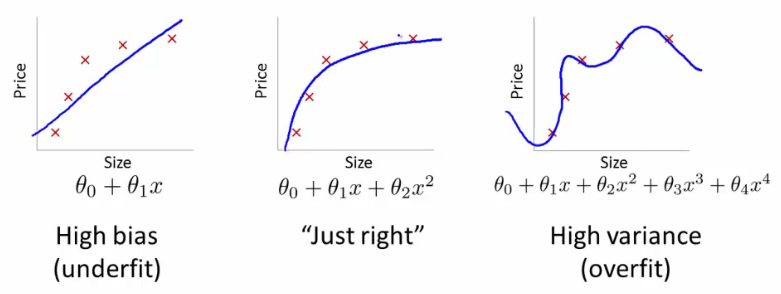
Regularization¶
- Insert additional requirement for regularizer $R(\beta)$ to be small: $$ \sum_{n=1}^{N}\left(x_{n}^{T}\beta-y_{n}\right)^{2}+\lambda R(\beta)\to\min_{\beta} $$
- $\lambda>0$ - hyperparameter.
- $R(\beta)$ penalizes complexity of models. $$ \begin{array}{ll} R(\beta)=||\beta||_{1} & \mbox{Lasso regression}\\ R(\beta)=||\beta||_{2}^{2} & \text{Ridge regression} \end{array} $$
- Not only accuracy matters for the solution but also model simplicity!
- $\lambda$ controls complexity of the model:$\uparrow\lambda\Leftrightarrow\text{complexity}$$\downarrow$.
Comments¶
Dependency of $\beta$ from $\lambda$ for ridge (A) and LASSO (B):
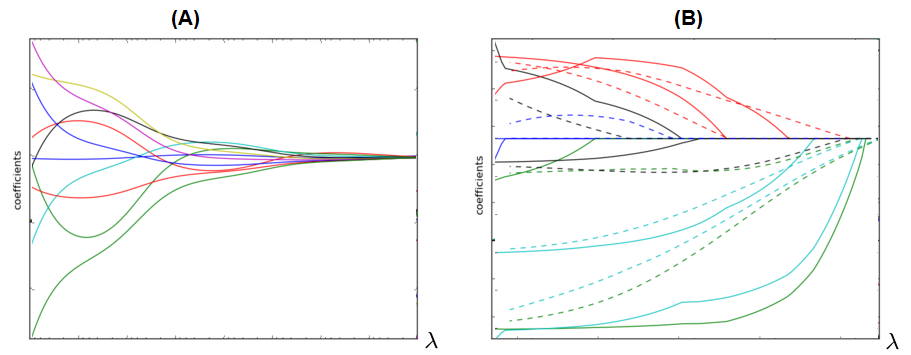
LASSO can be used for automatic feature selection.
- $\lambda$ is usually found using cross-validation on exponential grid, e.g. $[10^{-6},10^{-5},...10^{5},10^{6}]$.
- It's always recommended to use regularization because
- it gives smooth control over model complexity.
- reduces ambiguity for multiple solutions case.
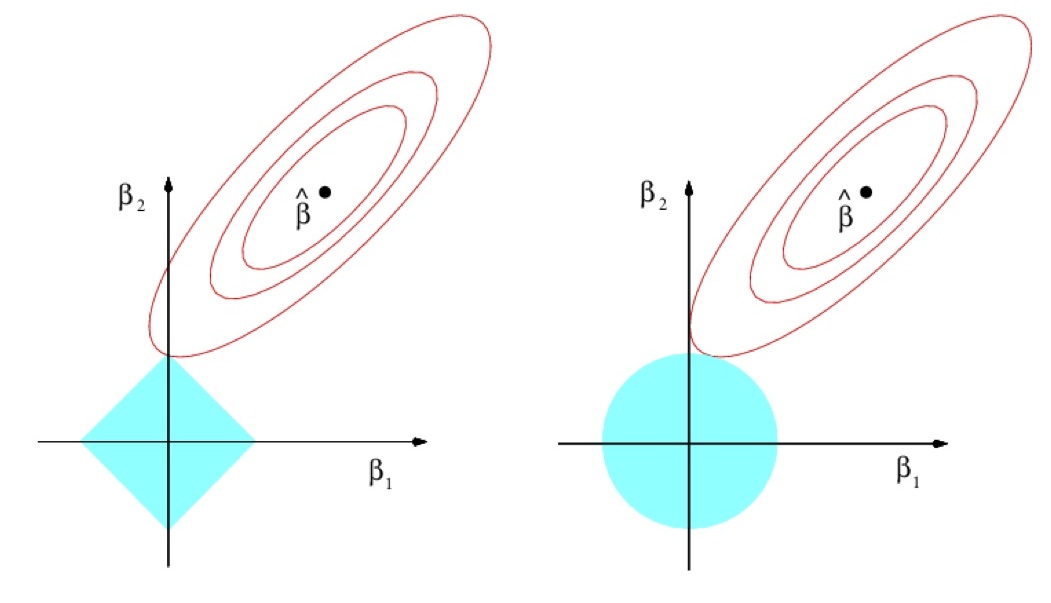
ElasticNet¶
- ElasticNet:
$$ R(\beta)=\alpha||\beta||_{1}+(1-\alpha)||\beta||_{2}^{2}\to\min_{\beta} $$ $\alpha\in(0,1)$ - hyperparameter, controlling impact of each part.
- If two features $x^{i}$and $x^{j}$ are equal:
- LASSO may take only one of them
- Ridge will take both with equal weight
- but it doesn't remove useless features
- ElasticNet both removes useless features but gives equal weight for usefull equal features
- good, because feature equality may be due to chance on this particular training set
Ridge regression analytic solution¶
Ridge regression criterion $$ \sum_{n=1}^{N}\left(x_{n}^{T}\beta-y_{n}\right)^{2}+\lambda\beta^{T}\beta\to\min_{\beta} $$
Stationarity condition can be written as:
$$ \begin{gathered}2\sum_{n=1}^{N}x_{n}\left(x_{n}^{T}\beta-y_{n}\right)+2\lambda\beta=0\\ 2X^{T}(X\beta-y)+\lambda\beta=0\\ \left(X^{T}X+\lambda I\right)\beta=X^{T}y \end{gathered} $$
so
$$ \widehat{\beta}=(X^{T}X+\lambda I)^{-1}X^{T}y $$
Comments¶
- $X^{T}X+\lambda I$ is always non-degenerate as a sum of:
- non-negative definite $X^{T}X$
- positive definite $\lambda I$
- Intuition:
- out of all valid solutions select one giving simplest model
- Other regularizations also restrict the set of solutions.
Different account for different features¶
- Traditional approach regularizes all features uniformly: $$ \sum_{n=1}^{N}\left(x_{n}^{T}\beta-y_{n}\right)^{2}+\lambda R(\beta)\to\min_{w} $$
- Suppose we have $K$ groups of features with indices: $$ I_{1},I_{2},...I_{K} $$
- We may control the impact of each group on the model by: $$ \sum_{n=1}^{N}\left(x_{n}^{T}\beta-y_{n}\right)^{2}+\lambda_{1}R(\{\beta_{i}|i\in I_{1}\})+...+\lambda_{K}R(\{\beta_{i}|i\in I_{K}\})\to\min_{w} $$
- $\lambda_{1},\lambda_{2},...\lambda_{K}$ can be set using cross-validation
- In practice use common regularizer but with different feature scaling.
Different loss-functions¶
Idea¶
- Generalize squared to arbitrary loss: $$ \sum_{n=1}^{N}\left(x^{T}\beta-y_{n}\right)^{2}\to\min_{\beta}\qquad\Longrightarrow\qquad\sum_{n=1}^{N}\mathcal{L}(x_{n}^{T}\beta-y_{n})\to\min_{\beta} $$
$$ \begin{array}{lll} \textbf{LOSS} & \textbf{NAME} & \textbf{PROPERTIES}\\ \mathcal{L}(\varepsilon)=\varepsilon^{2} & \text{quadratic} & \text{differentiable}\\ \mathcal{L}(\varepsilon)=\left|\varepsilon\right| & \text{absolute} & \text{robust}\\ \mathcal{L}(\varepsilon)=\begin{cases} \frac{1}{2}\varepsilon^{2}, & \left|\varepsilon\right|\le\delta\\ \delta\left(\left|\varepsilon\right|-\frac{1}{2}\delta\right) & \left|\varepsilon\right|>\delta \end{cases} & \text{Huber} & \text{differentiable, robust} \end{array} $$
- Robust means solution is robust to outliers in the training set.
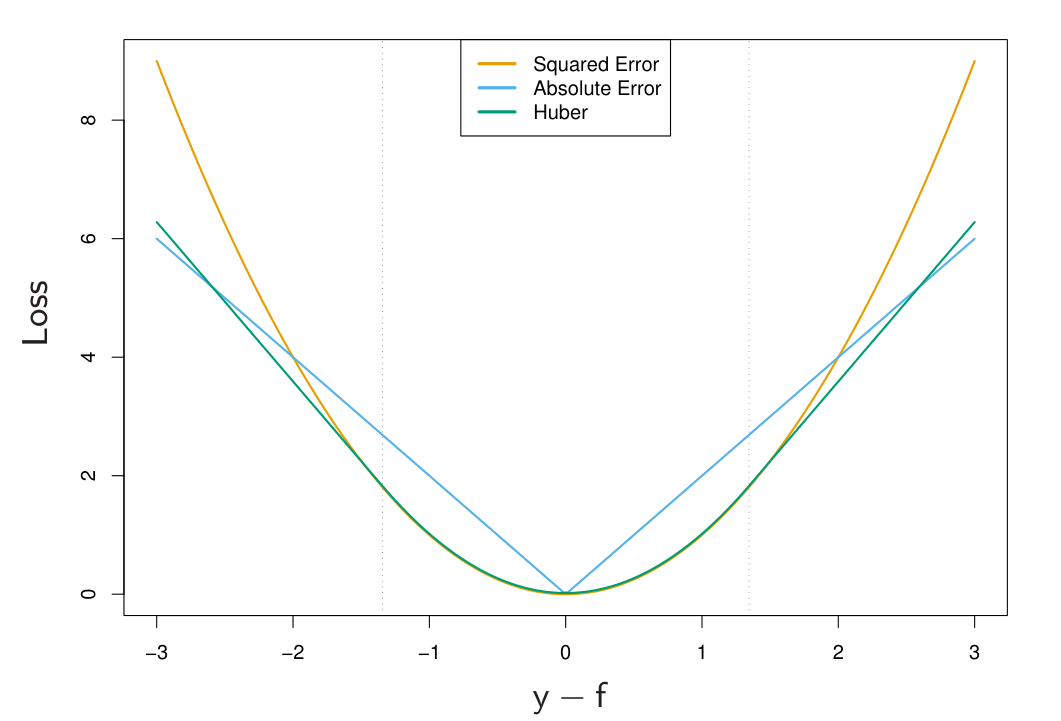
Loss function matters¶
- For $y_{1},...y_{N}\in\mathbb{R}$ constant minimizers $\widehat{\mu}$: $$ \begin{align*} \arg\min_{\mu}\sum_{n=1}^{N}(y_{n}-\mu)^{2} & = {\frac{1}{N}\sum_{n=1}^{N}y_{n}}\\ \arg\min_{\mu}\sum_{n=1}^{N}\left|y_{n}-\mu\right| & = {\text{ median}\{y_{1},...y_{N}\}} \end{align*} $$
For $x,y\sim P(x,y)$ and functional minimizers $f(x)$: $$ \begin{align*} \arg\min_{f(x)}\mathbb{E}\left\{ \left.\left(f(x)-y\right)^{2}\right|x\right\} & ={\mathbb{E}[y|x]}\\ \arg\min_{f(x)}\mathbb{E}\left\{ \left.|f(x)-y|\,\right|x\right\} & =\text{median}[y|x] \end{align*} $$
Weighted account for observations¶
Weighted account for observation¶
Weighted account for observations $$ \sum_{n=1}^{N}w_{n}(x_{n}^{T}\beta-y_{n})^{2} $$
- Weights may be:
- increased for incorrectly predicted objects
- algorithm becomes more oriented on error correction
- decreased for incorrectly predicted objects
- they may be considered outliers that break our model
Solution for weighted regression¶
$$ \sum_{n=1}^{N}w_{n}\left(x_{n}^{T}\beta-y_{n}\right)^{2}\to\min_{\beta\in\mathbb{R}} $$
Stationarity condition: $$ \sum_{n=1}^{N}w_{n}x_{n}^{d}\left(x_{n}^{T}\beta-y_{n}\right)=0 $$
Define $\{X\}_{n,d}=x_{n}^{d}$, $W=diag\{w_{1},...x_{N}\}$. Then
$$ X^{T}W\left(X\beta-y\right)=0 $$ $$ \beta=\left(X^{T}WX\right)^{-1}X^{T}Wy $$
Robust regression¶
Initialize $w_{1}=...=w_{N}=1/N$
Repeat:
- estimate regression $\widehat{y}(x)$ using observations $(x_{i},y_{i})$ with weights $w_{i}$.
- for each $i=1,2,...N$:
- re-estimate $\varepsilon_{i}=\widehat{y}(x_{i})-y_{i}$
- recalculate $w_{i}=K\left(\left|\varepsilon_{i}\right|\right)$
- normalize weights $w_{i}=\frac{w_{i}}{\sum_{n=1}^{N}w_{n}}$
Comments: $K(\cdot)$ is some decreasing function, repetition may be
* predefined number of times
* until convergence of model parameters.Example¶
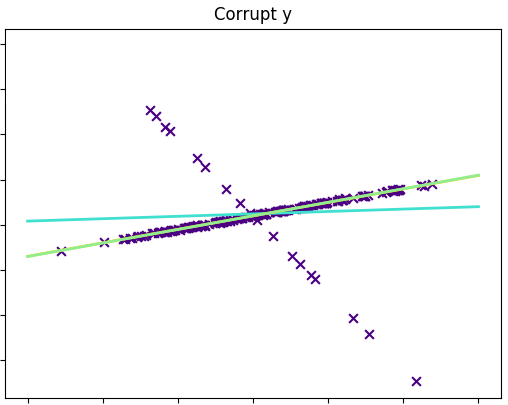
Nadaraya-Watson regression¶
Minimum squared error estimate¶
For training sample $\left(x_{1},y_{1}\right),...\left(x_{N},y_{N}\right)$ consider finding constant $\widehat{y}\in\mathbb{R}$ $$ L(\alpha)=\sum_{i=1}^{N}(\widehat{y}-y_{i})^{2}\to\min_{\widehat{y}\in\mathbb{R}} $$ $$ \frac{\partial L}{\partial\alpha}=2\sum_{i=1}^{N}\left(\widehat{y}-y_{i}\right)=0\text{, so }\widehat{y}=\frac{1}{N}\sum_{i=1}^{N}y_{i} $$
We need to model general curve $y(x)$:

Nadaraya-Watson regression - localized averaging approach.
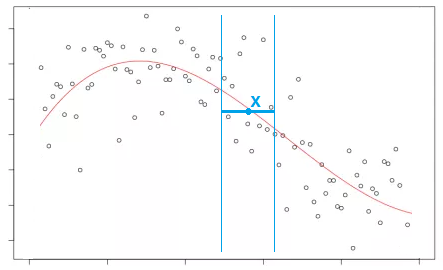
Nadaraya-Watson regression¶
- Equivalent names: local constant regression, kernel regression
- For each $x$ assume $f(x)=const=\alpha,\,\alpha\in\mathbb{R}$. $$ Q(\alpha,X_{training})=\sum_{i=1}^{N}w_{i}(x)(\alpha-y_{i})^{2}\to\min_{\alpha\in\mathbb{R}} $$
- Weights depend on the proximity of training objects to the predicted object:
$$ w_{i}(x)=K\left(\frac{\rho(x,x_{i})}{h}\right) $$
- $K(u)$ - some decreasing function, called kernel.
- $h(x)$ - some $\ge0$ function called bandwidth.
- Intuition: ``window width'', consider $h(x)=h,\,K(u)=\mathbb{I}[u\le1].$
Parameters¶
- Typically used $K(u)$: $$ \begin{eqnarray*} K_{G}(u) & = & e^{-\frac{1}{2}u^{2}}-\text{Gaussian kernel}\\ K_{P}(u) & = & (1-u^{2})^{2}\mathbb{I}[|u|<1]-\text{quartic kernel} \end{eqnarray*} $$
- Typically used $h(x)$:
- $h(x)=const$
- $h(x)=\rho(x,x_{i_{K}})$, where $x_{i_{K}}$ - $K$-th nearest neighbour.
- better for unequal distribution of objects
Solution¶
$$ \begin{align*} Q(\alpha,X_{training}) & =\sum_{i=1}^{N}w_{i}(x)(\alpha-y_{i})^{2}\to\min_{\alpha\in\mathbb{R}}\\ w_{i}(x) & =K\left(\frac{\rho(x,x_{i})}{h(x)}\right) \end{align*} $$
- From stationarity condition $\frac{\partial Q}{\partial\alpha}=0$ obtain optimal $\widehat{\alpha}(x)$: $$ f(x,\alpha)=\widehat{\alpha}(x)=\frac{\sum_{i=1}^{N}y_{i}w_{i}(x)}{\sum_{i=1}^{N}w_{i}(x)}=\frac{\sum_{i=1}^{N}y_{i}K\left(\frac{\rho(x,x_{i})}{h(x)}\right)}{\sum_{i=1}^{N}K\left(\frac{\rho(x,x_{i})}{h(x)}\right)} $$
Comments¶
- Under general regularity conditions $g(x,\alpha)\overset{P}{\to}E[y|x]$
- The specific form of the kernel function does not affect the accuracy much.
- but may affect efficiency
- Compared to K-NN: may use all objects, bandwidth controls smoothness
Comments¶
Insead of optimizing locally with constant $\alpha$ $$ Q(\alpha,X_{training})=\sum_{i=1}^{N}w_{i}(x)({\alpha}-y_{i})^{2}\to\min_{\alpha\in\mathbb{R}} $$
we could have optimized local linear regression $$ Q(\alpha,X_{training})=\sum_{i=1}^{N}w_{i}(x)({x^{T}\beta}-y_{i})^{2}\to\min_{\alpha\in\mathbb{R}} $$
This better handles approximation on the edges of domain and local extrema.

